A Private Tour today down in the Brecks. We wanted to visit a couple of different areas today, with a trip across into the Fens as well as some birding around the Forest. The forecast was for it to be grey and cold all day, but at least we avoided any rain and even saw some brief sunny intervals.
Our first stop was at Lakenheath Fen. As usual there was a lot of activity around the feeders, with a steady stream of tits and finches, mainly Chaffinches, Goldfinches and a couple of Greenfinches, and there were plenty of Reed Buntings in the bushes and reeds as well. We could hear Siskins and Redpolls calling, seemingly coming from the alders further along the path, but the latter had gone quiet by the time we got there and we only saw the Siskins as they flew off back towards the trees by the car park.
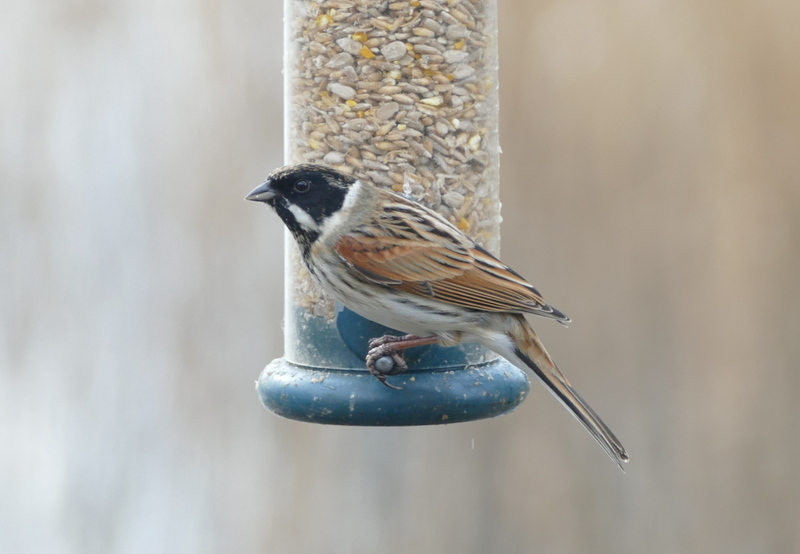 Reed Bunting – regular on the feeders at Lakenheath, here’s a recent photo
Reed Bunting – regular on the feeders at Lakenheath, here’s a recent photo
It was cold and windy up on the river bank at the Washland Viewpoint, and there is still a lot of water on Hockwold Washes. There was a good selection of wildfowl on view – Wigeon, Gadwall, Teal and Shoveler – and a gang of Tufted Duck on the river. We could see several Little Egrets, but no sign of the Great White Egret on here today. We had quite a lot of ground to cover if we wanted to explore the whole of the reserve this morning, so we didn’t linger too long and set off back round to the main path.
Out at the New Fen Viewpoint, the newly opened out areas of open water and cut reed look very promising, but on our first scan we couldn’t see much around the pools, a few duck, several Coot and a pair of sleeping Canada Geese. However, our attention was drawn to a very smart male Marsh Harrier hanging over the reeds further back, calling. We could see his pale silvery grey and black wingtips, and pale head and breast contrasting with rufous belly underneath. A female Marsh Harrier appeared from the reeds and started to circle below him, slightly larger than the male. The two then proceeded to mock talon grapple, the male dropping repeatedly towards the female, who would then turn upside down and raise her talons, classic Marsh Harrier display activity and great to watch. Spring is in the air and the breeding season is now upon us!
Another scan across the fen revealed a head come up out of the reeds. It had to be a tall bird and indeed it was – a Common Crane. We got it in the scope and had a great view – the black face and foreneck contrasting with white neck sides and the bright red patch on the top of the head. The bird kept bending down to feed, then stretching up again to look around.
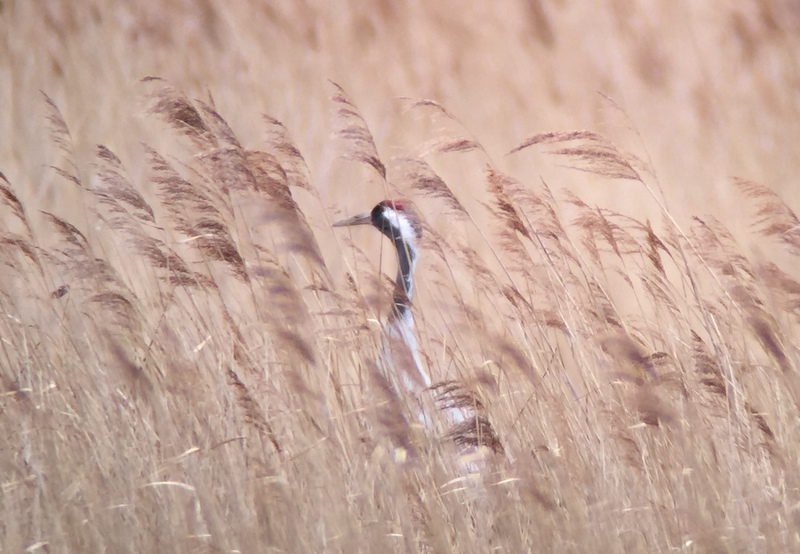 Common Crane – a head appeared above the reeds
Common Crane – a head appeared above the reeds
While we watched, a second head then appeared next to it, slightly smaller, not as tall as the first. They were a pair of Common Cranes, the smaller bird being the female. They were obviously in a small clearing in the reeds and made their way slowly across, briefly passing across behind a thin line of lower reeds where we could see more of them, before disappearing out of view again.
 Common Cranes – a pair in the reeds together
Common Cranes – a pair in the reeds together
That was a great start, so we continued out across the reserve to see what else we could find. There were lots of Cetti’s Warblers singing unseen from deep within the reeds, and plenty of Reed Buntings calling, but it is still a month or so yet before the reedbeds will come alive with the songs of the returning Reed Warblers and Sedge Warblers. As we walked down towards the West Wood, we could hear Bearded Tits calling though. A male appeared briefly in the top of the reeds, but it was hard to pick up amongst all the seed heads blowing in the breeze and dropped down again all too quickly before we could get the scope onto it.
A Kingfisher was perched in the reeds across the pool in front of Mere Hide when we arrived. The glass windows are a bit dirty at the moment, with lots of greasy fingerprints, and when we tried to ease one open very quietly it unfortunately flew off round the corner out of view. However, we were glad we had the window open a few seconds later as it meant we had a great view of a cracking male Bearded Tit which flew across the water right below us.
As we approached the Joist Fen Viewpoint, we heard what sounded like a single boom from a Bittern. We stopped to see if we could hear it again, but annoyingly it had gone quiet again. We continued to listen from up at the viewpoint. Looking out across Joist Fen, there were several more Marsh Harriers circling over the reeds and a Cormorant standing on the tall post. We had a look in the paddock for any Cranes but all we could see in there today was a few Greylag Geese.
We turned round to scan the reeds behind again, just in time to see two enormous birds flying round the back of West Wood over the river. Two Common Cranes, perhaps the same two we had seen earlier on New Fen? Even better, they then turned slightly and headed straight for us, flying over the Viewpoint and almost over our heads! We had stunning views as they flew towards us in one of the rare moments of sunshine.
 Common Crane – this pair flew over Joist Fen Viewpoint…
Common Crane – this pair flew over Joist Fen Viewpoint…
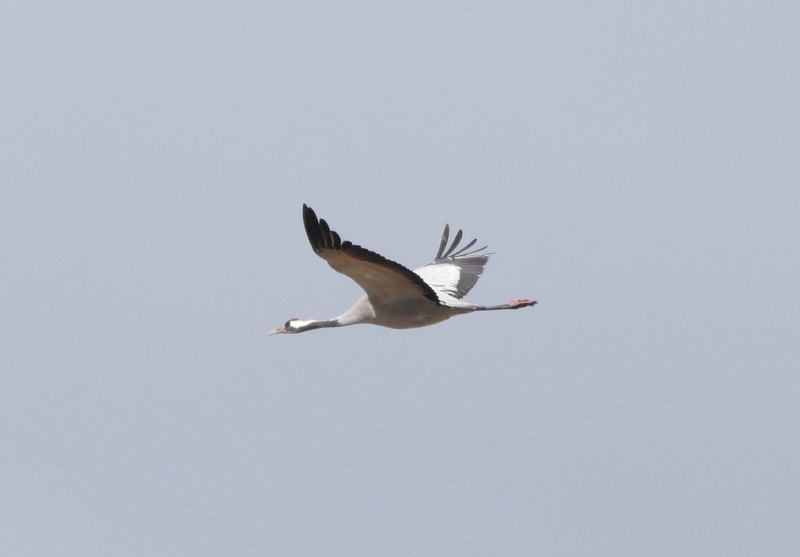 Common Crane – they came almost overhead at one point…
Common Crane – they came almost overhead at one point…
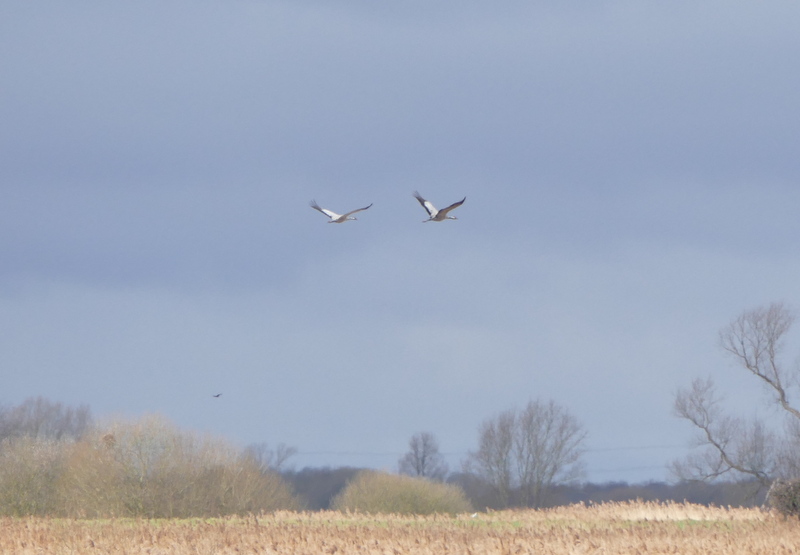 Common Crane – before dropping down into the reeds beyond
Common Crane – before dropping down into the reeds beyond
From there, we decided to have a quick look round from up on the river bank. The first white shape we looked at was a Mute Swan, but a second one further along was a Great White Egret. It was rather distant, and there was no real desire to walk further along for a better view, but through the scope we could see its long, dagger-shaped yellow bill when it stopped preening and raised its head briefly.
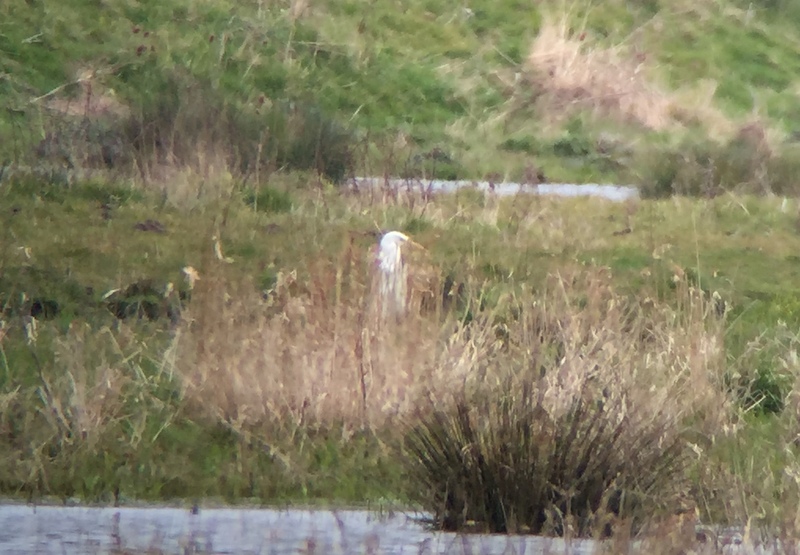 Great White Egret – visible distantly from the river bank
Great White Egret – visible distantly from the river bank
A Little Egret nearby was much more obliging, posing for photos before flying off over the bank the other side, where another three Little Egrets were seen flying around.
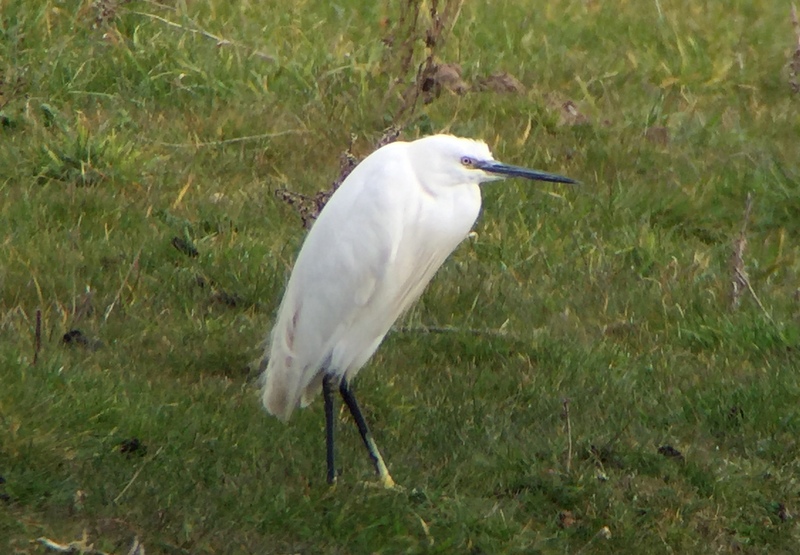 Little Egret – much more obliging!
Little Egret – much more obliging!
That all made for a very successful early season look round the reserve this morning, particularly on such a grey day, so we made our way back to the Visitor Centre. Lakenheath Fen is a large reserve and it takes a bit of time to explore, so the morning was already all but gone by the time we headed off into the Forest.
The walk down one of the rides through the commercial pine plantations was fairly quiet as usual, until we were almost at the clearing. Then the distinctive ‘glip, glip’ call of Common Crossbills echoed through the trees. We had a scan of the sky above the ride ahead, but they obviously didn’t come our way and we couldn’t see them through the trees.
It was rather cold and exposed out in the clearing, and there was not much activity at first. A couple of Mistle Thrushes flew off as we arrived and a pair of Skylarks flew across and landed not far from us. We made our way across to the other side and could hear Woodlarks calling. One fluttered up across the back of the clearing briefly, singing rather half-heartedly – and it seemed like that would be the sum total of their performance today. Fortunately, as we walked back round, another Woodlark flew up and perched on a post where we could get it in the scope and have a better look at its key distinguishing features. At that point, we heard the ‘glip, glip’ of Crossbills again and this time we saw them come flying across, over our heads and away over the trees beside us.
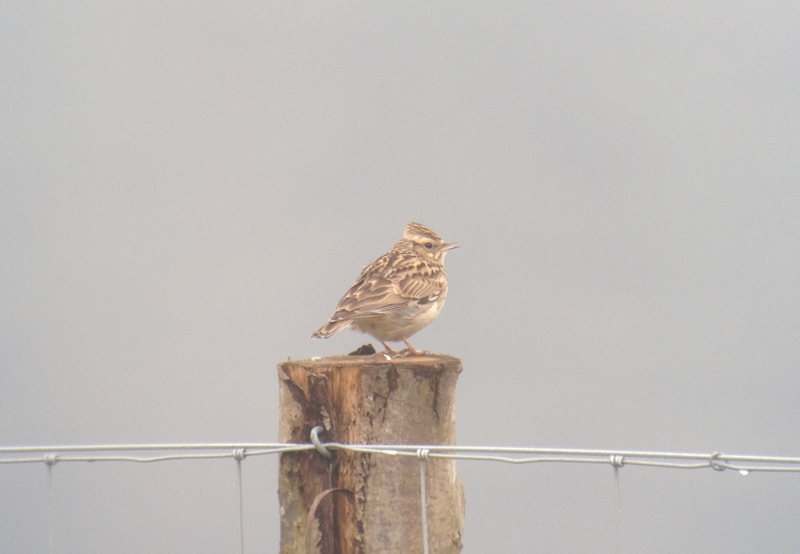 Woodlark – one perched on a post today, just like this recent photo
Woodlark – one perched on a post today, just like this recent photo
The raptors were rather subdued today, in the cold and grey weather, but we did see six Common Buzzards circle up over the trees at one point. It was not ideal weather for Goshawks, and with a lot to pack in today we decided not to wait here long. As we made our way back via a different route, we flushed another two pairs of Woodlarks from beside the path. One pair landed in a small clearing nearby, where we could see them creeping through the grass.
 Woodlark – one of two pairs by the path on our way back
Woodlark – one of two pairs by the path on our way back
Our next destination was Grime’s Graves and the Great Grey Shrike was obligingly on view as usual, as soon as we arrived. It was a little distant at first, but easy to pick up. Even though rather small, a little shorter in length than a Blackbird and slighter in build, it really stood out as a bright white dot perched high in the top of a small bare tree. Through the scope, we could see more detail – the black bandit mask and black wings contrasting with the very pale silvery grey upperparts and bright white underneath.
The Great Grey Shrike flew across to the top of another taller tree and then seemed disinclined to do very much. It remained perched there for ages, looking round, not flying down to the ground repeatedly, looking for food, as it normally does. Having seen it so quickly, and not bad views through the scope, we decided we would move on. However, as we walked back it suddenly became more active again and started flying around between the bushes. It even had the decency to come much closer to us, and we had great views of it now from the path.
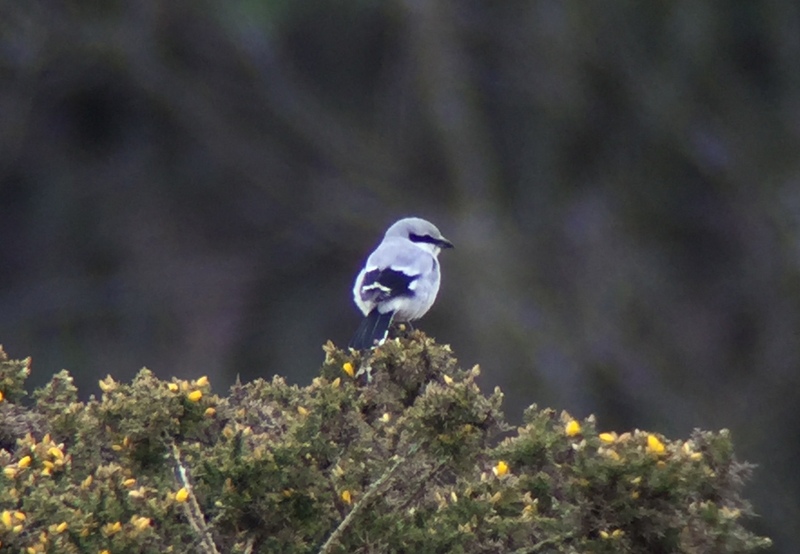 Great Grey Shrike – showed very well again, in the end
Great Grey Shrike – showed very well again, in the end
We drove round to Lynford Arboretum and walked out along the track, stopping by the gate to look at the feeders. Lots of seed was spread on the ground today, and the birds were mostly feeding on this rather than the fat balls. A steady stream of Blue Tits, Great Tits and Coal Tits dropped down to forage in the leaves. There were plenty of Chaffinches but there has still been next to no sign of the Hawfinches using this area, so we didn’t stop here too long. We had a quick walk around the arboretum. There were several Goldcrests singing in the fir trees but very little else in here this afternoon. Down at the bridge, there was no food put out today so activity here was rather more limited than usual. However, a Marsh Tit appeared right in front of us, which was a nice addition to the day’s list.
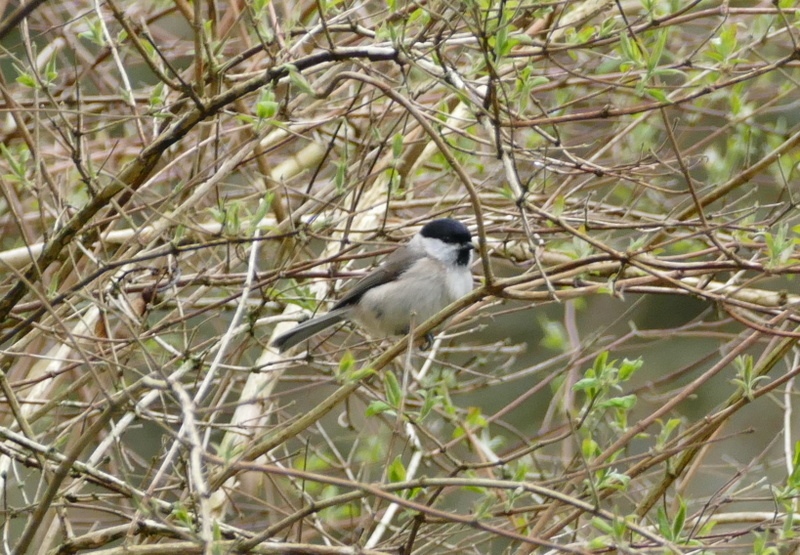 Marsh Tit – one was by the bridge today, this photo from last year here
Marsh Tit – one was by the bridge today, this photo from last year here
At this point we heard the news that 10 Hawfinches had been seen a little earlier around the paddocks, so we made our way down there to see if we could see them. There have been small numbers feeding in the paddocks on and off all winter, but generally no more than 3-4 (and sometimes just a single female), so this would be a very good number for here this year. It is not so long ago that it was possible to see 30+ Hawfinches here, but this is a species that has been declining everywhere, including at strongholds such as this.
As soon as we arrived we could hear Hawfinches calling, and we were just in time to see them all fly up from beneath the trees. Several small groups flew round in different directions, and we watched as one party of four flew off high away from us and disappeared into the distance. Thankfully others remained in the trees around the paddocks, or in the tops of the trees in the distance beyond, and we could hear Hawfinches calling everywhere, and see birds flitting around in the hornbeams or flying back and forth. At one point we managed to count nine in view at the same time, so assuming the four had not returned unseen that would imply at least thirteen.
Three Hawfinches flew across from one of the hornbeams to the trees by the lake, so we walked along to try to get a closer look at them. We could hear them calling, but unfortunately just at that moment a jogger came along the track towards us and we didn’t see which way they went. As we walked back to look in the paddocks again, six Hawfinches flew out in a group – but we couldn’t tell if the earlier three had flown back in to join them or not. They circled round and landed in the tops of the trees by the bridge. At the same time, at least one bird was still in the treetops beyond. It was great to see and hear so many around here today, but it was hard to know just how many there were, there was so much activity!
 Hawfinch – a bright male
Hawfinch – a bright male
We walked down alongside the paddocks and a single Hawfinch was still calling from deep in the trees. As we stood a while, more started to fly back in and this time several perched up for a while in full view. We got them in the scope and got fantastic views of them now, both bright males and slightly duller brown females with less extensive black face masks around their still very hefty bills.
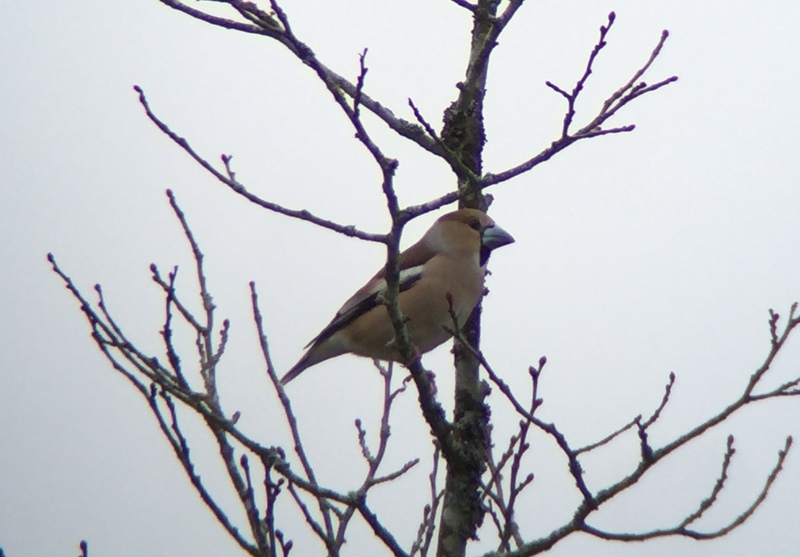 Hawfinch – a slightly duller brown female
Hawfinch – a slightly duller brown female
In between all the Hawfinch excitement, we found a little time to look at some of the other birds here. The Little Grebes were cackling away as usual on the lake. The Kestrel was flying around the paddocks, perching up on the wires again. A flock of Redwings flew up from the damp edge of the paddocks to perch up in the alders by the lake. We had a walk round to the end of the paddocks, and it was getting late in the afternoon now. With a long drive home ahead, we had a request to call it a day, so made our way back to the car park.
However, we were still not completely finished. On our way back over the bridge, we could hear a Hawfinch calling and looked up to see one perched in up in the trees beside the lake. We couldn’t resist a final look at it in the scope, before it flew off back across the paddocks. A great way to end the day, after such a fantastic Hawfinch performance.
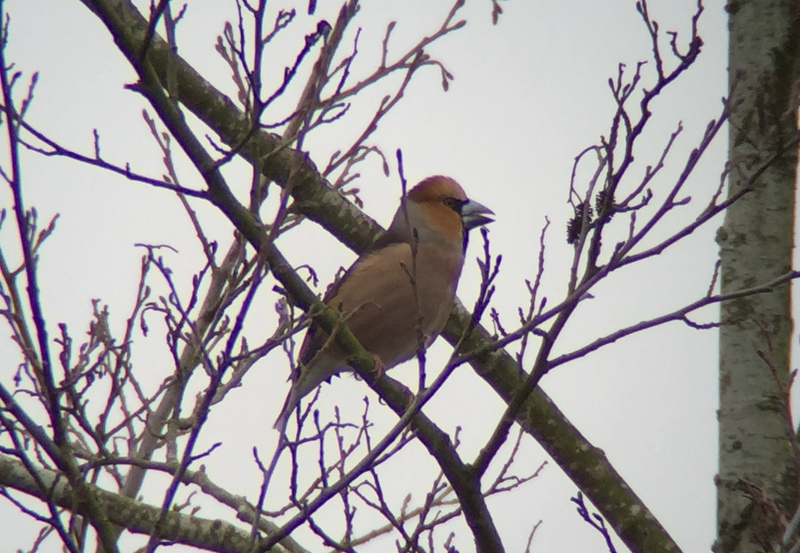 Hawfinch – bidding us farewell, as we walked back to the car
Hawfinch – bidding us farewell, as we walked back to the car
















